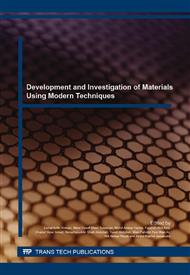p.175
p.180
p.185
p.191
p.197
p.202
p.207
p.213
p.220
The Formation of Cobalt Chromium Molybdenum (CoCrMo) Foams Fabricated by Slurry Method
Abstract:
Cobalt Chromium Molybdenum (CoCrMo) is a metal that are widely used in the biomedical field of orthopedic applications. CoCrMo foam was developed in the form of a porous structure where it has a high porosity on the surface with the different pore sizes and shapes. This research is intended to produce CoCrMo foam by using slurry method and to study the effect of composition and sintering temperature on the metal foams. The slurry of CoCrMo was prepared by mixing the binder materials of Methylcellulose (CMC), Polyethylene Glycol (PEG) and distilled water for an hour. Followed by mixing and stirring the CoCrMo powder for another 1 hour until it becomes slurries. Polyurethane (PU) foam was then impregnated into the slurry and dried for a day in the oven with 60 °C. Sintering process is carried out at temperature of 1000 °C, 1100 °C and 1200 °C using a tube furnace. Then sample of CoCrMo foam was going through a shrinkage measurement, microstructure analysis by using Scanning Electron Microscope (SEM), analysis of element by using Energy Diffraction X-ray (EDX) and also the density and porosity test by using Archimedes method. The sample with the composition of 65wt% was the best result in this experiment. While sintering temperature of 1200 °C produced the highest number of porosities. The shrinkage percentage is from 2.67% to 14.13%. The density obtained is in between 1.538 g/cm3 and 2.706 g/cm3 while the percentage of porosity is from 50.284% to 78.934%. The average pore size is in the range of 249.63μm to 445.38μm. The best sintering temperature and composition to produced high porosity were on 1200 °C and 65wt%.
Info:
Periodical:
Pages:
197-201
Citation:
Online since:
January 2016
Keywords:
Price:
Сopyright:
© 2016 Trans Tech Publications Ltd. All Rights Reserved
Share:
Citation:


